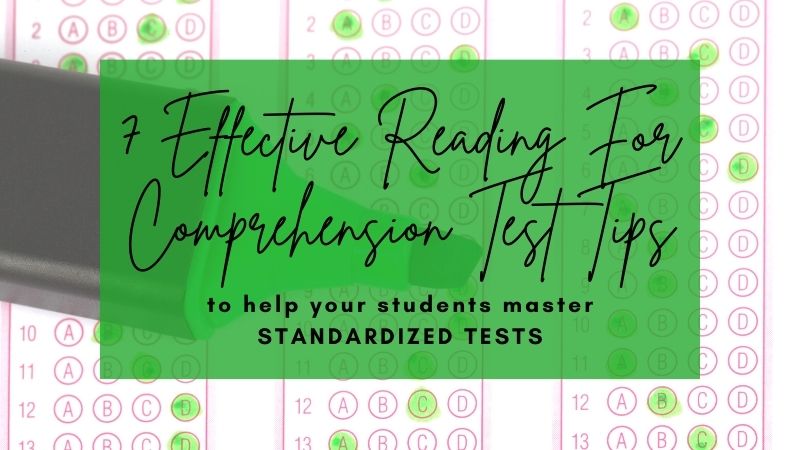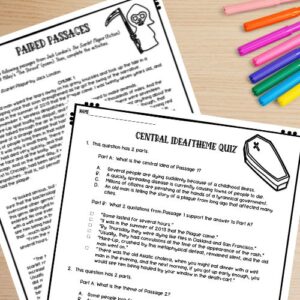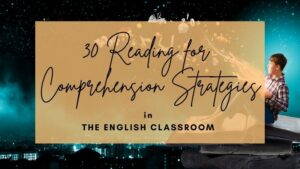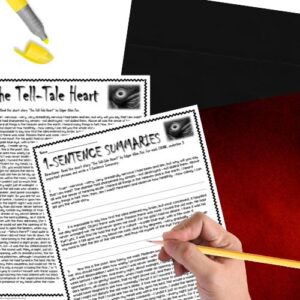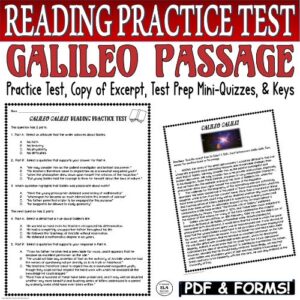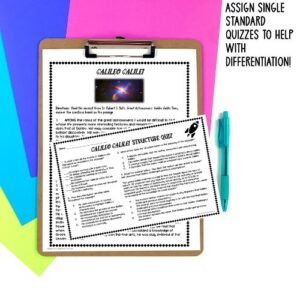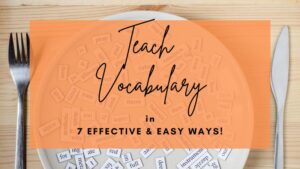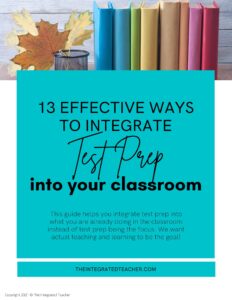A Reading for Comprehension Test is usually dreaded by teachers, parents, administrators, and students alike. We know that our students are always growing, but high-stakes tests tend to bring out the fear and overwhelm within all of us.
We cannot escape some sort of standardized testing within the public, private, charter, and even homeschooling educational spheres. Likewise, our students cannot run from this part of academia as there is always a Reading For Comprehension Test to take!
So, let’s help our students in any way we can! Our students can grow their skills by taking a reading for comprehension test with a mix of determination, hard work, effective teaching, and resilience.
Need help with Test Prep? Check out this FREE Pack of 3 Test Prep Activities to help students achieve success on a Reading For Comprehension Test!
Why do we need a reading for comprehension test in education?
First, let me explain a little concerning the idea of reading comprehension testing as a vital element of teaching effectively.
There are 3 primary reasons why we need some sort of standardized testing:
- We need to know where our students are starting at. Without some sort of assessment, it is difficult to know where our students are when it comes to their abilities.
- We need to know if what we are doing as educators is actually working. Too often, I have been in professional development sessions where I have been told to teach in some way that directly contradicts what I know really works.
- We need to know if there is a trend of growth or regression. One year, I had a student who was a level 4 reading student (above average on the state test) who came to school after having a horrible experience at home. She completely underperformed due to extreme stress and earned a level 2 on the state test. The next year, she was back at level 4.
When it comes to taking a Reading For Comprehension Test, however, there are many cons that can be avoided if schools really want to see growth:
- I am not in favor of making it the end-all-be-all for students. Students should have options and varied ways to communicate their learning.
- I am not in favor of using the test to label students for honors, AP, dual enrollment, etc. courses. All students who desire should have access to higher-level classes.
- I am not in favor of monetarily linking growth to teachers. Students learn at different rates and newer or struggling teachers especially need help, not harsh demands.
- I am not in favor of only allowing one test to be the sole measure of progress. Offering multiple opportunities throughout the year is way more important in knowing if a student has grown.
- I am not in favor of letting big testing companies run the show. They can change the bar, craft ridiculous questions/answers, or use passages that are simply unreadable for students.
- I am not in favor of norm-referencing tests. If there is a standard, don’t keep moving the goalpost or use the test to compare to other students. Meeting the standards should be the main goal.
- I am not in favor of teaching to the test. Skills to take a reading for comprehension test are gained over time. When students read a lot, they will grow. Students need exposure to a solid phonics curriculum, a wide range and level of vocabulary instruction, and standards-based reading comprehension skills. BUT this process should be integrated throughout the year.
7 Reading for Comprehension Test Tips
1. INCORPORATE CRITICAL THINKING QUESTIONS
When it comes down to it, kids need to consistently come into contact with what they will experience on test day. They will never get a question about identifying a protagonist, a type of conflict, or a literary device.
Instead, students will be questioned about how the characterization develops the theme, the impact of the conflict, and the purpose for a description of a situation. Help students by providing critical thinking questions with reading comprehension stems that mirror the standardized test.
That way they will feel and actually BE more prepared when they see the questions on the exam.
CLICK BELOW TO GET A CENTRAL IDEA PACK WITH TEST PREP QUESTIONS BASED ON A SET OF PAIRED PASSAGES!
2. PRACTICE WRITING RESPONSES WITH TEMPLATES
Struggling students need an easy-to-remember go-to in order to lessen the stress associated with writing.
For many, writing templates, or “formulaic writing,” is a dirty phrase. Because of this association, teachers may avoid them. Students, however, need a template. The sentences don’t have to start or end the same or include a specific set of transitions or examples.
Instead, think of writing like playing a sport. Basketball coaches encourage their players to practice drills in an incredibly formulaic way. Once the player masters the skills, he or she can add on to or eliminate a process no longer needed.
The same is true in writing, as we want all students to master those skills and be successful.
Click HERE to get a THEME Short Response FREEBIE!
3. USE SMALL GROUP INSTRUCTION FOR SPECIFIC STANDARDS
When students take beginning-of-the-year reading tests, we can see the areas they struggle in the most. To really focus on students’ individual needs, you can create centers with activities and questions that revolve around either strategies or the standards.
For example, if one group of students needs help with central idea, you can walk them through a 1-sentence summary activity. If another group needs help with making inferences, you could guide them through an inference activity.
Through small groups, every student will have the opportunity for one-on-one interaction with the teacher.
4. ENCOURAGE STUDENTS TO VISUALIZE WHAT THEY READ
By creating an image, what is read sticks to our minds more readily. Unfortunately, not all students have this innate skill as a part of who they are as readers.
Because of this struggle, we have to teach what this looks like. We have to actively model how to visualize and that it is necessary. Images help us to understand and then remember what we read. Without it, what we just read gets lost in all of the words we stuff into our brains.
Instead, model the process you go through when you visualize. Pretend you are a struggling reader that needs help with a reading for comprehension test and think aloud the steps you would take to visualize the text paragraph by paragraph or page by page.
5. HAVE STUDENTS LOCATE THE EVIDENCE FOR ANSWERS
I have found the #1 BEST thing for students to do when practicing for a reading for comprehension test is to go back to find the evidence that supports or negates a specific answer choice.
By locating evidence, students force themselves to interact with the text and answer choices, instead of merely thinking one answer is better. They can KNOW that what they have chosen is the BEST answer choice. In fact, having students try to find the answer in the text before even looking at any options enables students to avoid the distraction of wrong responses. They will KNOW they have found the right answer.
In KNOWING, they will feel more confident on reading for comprehension test day!
Want easy-to-implement reading strategies? Check out 30 strategies to help your students master reading comprehension!
6. BREAK UP TEXTS INTO CHUNKS AND SUMMARIZE
Chunking can work for any text like poetry, short stories, plays, and essays! I am a big proponent of taking one small bite at a time to conquer any large feat. For some students, this large feat is the state exam. Reading longer texts or shorter, more complex texts can be a true struggle.
Model how to write 1-Sentence Summaries for each CHUNK. The chunk could be a paragraph, a group of paragraphs, or even an entire page. The purpose is to get students to write about and understand what they are reading.
By the end of the text, they should better comprehend by writing down a quick 1-Sentence Summary. It doesn’t have to be long, but it should relate to the central idea of that chunk and ultimately the main idea of the entire text.
Want a quick and easy summary activity for “The Tell-Tale Heart?” Click below!
7. ANNOTATE FOR EVERY TEXT STUDENTS READ
The skill of annotation is something students will need for a lifetime. Most importantly, it must be taught through modeling, especially when students prepare for a Reading For Comprehension Test. If you tell kids to “annotate a text,” you cannot assume they know how.
They will randomly underline parts that have little meaning, or they will underline everything. Or the dreaded highlighter comes out to wreak havoc with bright yellow ink on every page.
Instead, have students focus on meaning, purpose, characterization, and vocabulary. With a specific area of focus, they can then learn to “annotate” or take notes. You could have them underline, circle, box…whatever, but they have to comment on that part and interact with it.
By making a small note, they learn and grow and remember. Annotations will help in taking a reading for comprehension test!
Need PRINT & TEACH reading test prep quizzes to help with a Reading For Comprehension Test? Click BELOW!
Do your students need help with learning vocabulary as they prepare for a Reading For Comprehension Test? Check out “Teach Vocabulary in 7 Easy Ways!”

